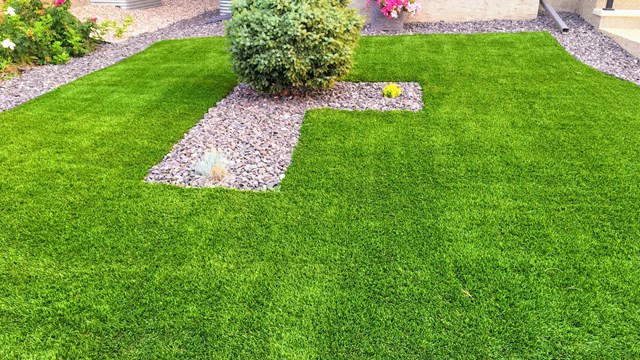From damp basements to flooded walkways and backed-up storm drains, too much water without a place to go can be a huge problem for condominiums. In recent years, rain gardens have come to the fore as a make-ready solution to those problems.
First created in the early 1990s by stormwater specialists in Maryland, rain gardens are shallow depressions in the soil that serve as planting beds for hardy plants and flowers. These depressions are designed to catch runoff water from impervious sources such as driveways, roofs and parking lots. The water is then filtered through a specially-formulated soil back into the groundwater system below. “The (finished) depression is usually six inches to a foot deep,” says Michael F. Clark, P.E., New England regional manager of Weston & Sampson, Inc., and an expert in the creation and design of rain gardens. “The runoff enters the garden, filters through the soil mix which interacts with the rain water to remove sediments, trash and litter but also reduces pollutants, specifically nitrogen and phosphorus.” The two to three feet of special soil in a rain garden can also bind up with other contaminants including oil and grease from car engines. “Instead of running off into lakes and ponds, the water filters back into the ground.”
The plants for an effective rain garden have to be selected carefully, Clark says. “These plants could be saturated for up to three days at a time and in late summer, they’ll be dry, so they have to be drought-resistant as well. Popular plants on the East Coast include inkberry, winterberry, gay feather, sweet fern, different types of day lilies, hydrangeas and dogwood. “You want plants that not only are the right types but which look good together,” Clark says. “You also want totry to use native plants or plants that won’t get out of control or become invasive.”
In small condominiums, these gardens are usually planted in a spot that can catch runoff from roofs and driveways. In larger complexes, they may be planted to catch runoff from multiple roofs or perhaps at the edge of parking lots or other expansive paved areas.
Many Benefits
The benefits of rain gardens are many and varied. Dealing with excess water is first and foremost on that list. “Because we’ve built on every stitch of land we can that’s good land, we’re now building on sites that shouldn’t bebuilt on,” says Monique Allen, owner of The Garden Continuum Inc. in Medford, Massachusetts. “We’re building on hard [ground] sites now and you have to drain all that water” that collects and has nowhere to go.
That runoff can lead to major environmental issues, says Ed Himlan, executive director of the Massachusetts Watershed Coalition. “On a hot summer day when a thunderstorm hits and the rain comes down and comes in contact with the heated pavement, that water will become a lot warmer,” he says. Water then goes right to the storm drain and is deposited into the nearest creeks, rivers and streams, often within minutes. That warmed water “stresses the ability of aquatic life to survive. It’s a heated toxic mix that’s going into that stream,” Himlan says. “The more densely developed the area, the greater the impact. There can be a dramatic shift in the ecosystem if the stream supportsfewer and fewer living things.”
Free-flowing water can also choke rivers with the debris that is carried through the storm drains. In a stream near his hometown, Himlan says, it was a foot to two feet deep in sand. “The heavier materials remain in the stream bed and that chokes off anything that could be living there. The lighter stuff floats downstream,” in this case to a swimming area that had to be closed because of the refuse.
Also factor in that homes are being built closer to each other and that means that excessive water runoff can impact neighbors and entire neighborhoods. Many municipalities have rules in place preventing one resident from allowing their water to have an outlet on someone else’s property. That means that builders andhomeowners have to site retention basins everywhere or build special drainage apparatuses underground, often at a fairly large cost. Not only are these storage basins expensive, they also can provide a breeding ground for mosquitoes and pose a drowning hazard for young children.
In coming years, the issue of excessive water runoff will likely become more problematic in New England. “What everyone has to remember is that climate change for New England means more rain,” says Allen. “We’re getting a lot of snow right now but translate that to October or April or one of the other rainy months and you’ll see that increased precipitation could be a problem.”
That added water means problems for houses as well as the environment. “Seventy-five percent of damp basements come from poor drainage,” Allen says.
Rain gardens can reduce many of these problems, sending the excess water back into the ground and purifying it in the process. “When the water flows through the ground, it has a chance to cool off because it’s a longer process” in getting back to the rivers and streams, Himlan says. “It could be months before it gets to a stream and as it goes through the rain garden, the materials there – the soil and plants – remove 95 percent or more of the pollutants.”
A Worthwhile Investment
When it comes to building and maintaining a rain garden, the initial investment in time and resources might not be cheap, but both will pay off in the end. “They’re not much more cost-wise” than regular landscape construction, says Clark. “There’s a bit more bed preparation and flower selection.” Also, machinery will have to be rented to dig the holes and the right type of soil mix will have to be found and purchased. The payoff comes, though, in reducing the number of man-made drainage systems that need to be installed on a housing site. “In a new home or condo complex, youmay be able to reduce the number of pipes and catch basins,” Clark says.
Adds Allen, “When you have a condo complex, you have a lot of pavement. There are new laws hitting the books for storm water management.” Right now, they apply to parcels over five acres but sites between 2.5 to 5 acres are now being targeted, which can be expensive for complexes. Rain gardens can provide a simpler and more effective alternative.
Plus, they are easy to care for. “They’re very easy,” Allen says. “You won’t have to be fertilizing. You don’t have to water it.” Early on, maintenance might be a bit more intense until the landscaper finds the right balance of plants. “You don’t want to put all of one plant [species] in there because there will be attrition. You might want to put in 12 different plant species with 9 to 11 plants. One might die butyou’ll still have the other 11 species.”
Soon you’ll see which ones are thriving and can then plant more of those to replace those that do not initially work out. Within a season or two, the right mix will be established and thriving.
Clark says other regular maintenance includes removing sand for those rain gardens in the Northeast and Midwest. Because of snow removal and sanding efforts during the winter months, sand will enter the rain garden, especially in the spring months, so work crews will have to remove that a few times during the growing season. Rain gardens also catch leaf debris and litter or trash, and those elements must also be removed. Every 25 years or so, the two to three feet of special soil beneath the rain garden can be replaced after it becomessaturated with the contaminants it regularly filters, says Clark.
In addition to all that they do for the environment, rain gardens also canhelp with the general aesthetics of the complex. “Condo complexes need to look pretty and catchwater basins are not pretty,” Allen says. “You have to sell your units and units sell better when they’re beautiful. Someone sees a 200-foot-long garden and they think, ‘Wow, beautiful,’ and little do they know, all the drains are running into that. These gardens can be a beautiful aesthetic draw in a larger living environment.”
Snow Storage Areas
In the winter months, these gardens also serve a practical purpose. “They become great places to push snow,” Allen says. Many condo complexes will landscape with shrubs or small trees – delicate foliage that can be damaged or destroyed under the weight of giant winter snowdrifts. The perennials filling a rain garden won’t suffer under that pressure. And if they do, they’re cheaper to replace than shrubs or trees.
To create a rain garden requires a bit of expertise and it’s worth it to do some investigation before beginning the process. For larger rain garden projects, Clark recommends hiring an engineer or landscape architect to help get everything straight on the first go-round. Or, Himlan says, you can work with your regular landscaper and ask him or her to investigate the process. For smaller, more personal size rain gardens, he suggests researching their construction online first before simply diving in and digging. Allen directs people to their local municipalities as well as the Massachusetts Department of Environmental Protection, which provides information on building one of these extraordinary gardens. Himlan suggests visiting the Kansas City, Missouri municipal website, which offers a number of tips and how-to's on rain gardens, an environmental project to which the city has committeditself deeply in an effort to improve its lakes and streams.
Although they may cost more at the beginning of the process and may require just an extra bit of care here and there, rain gardens can end up saving thousands of dollars for a condo complex in search of a solution for its water problems. Beyond that, there’s the satisfaction of knowing that you are helping preserve and protect the freshwater lakes, inlets and ponds that are so dear to every New Englander’s heart. And best of all, the gardens will bring beauty to any landscape. Who can say no to such hard-workingflowers?
Liz Lent is a freelance writer and a frequent contributor to New England Condominium magazine.






Leave a Comment